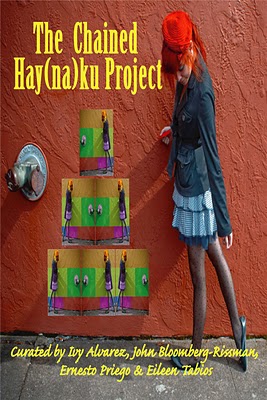The Chained Hay(na)ku Project
curated by Ivy Alvarez, John Bloomberg-Rissman, Ernesto Priego, & Eileen Tabios
The Chained Hay(na)ku Project
curated by Ivy Alvarez, John Bloomberg-Rissman, Ernesto Priego, & Eileen Tabios
reviewed by
Ariadne Unst
An exciting adventure in creating linked poems in the hay(na)ku form.
Factoids:
- Third anthology based on hay(na)ku form.
- First anthology of collaborative (three or more participants) hay(na)ku form:
compare with the rengay and the renku.
- Includes not only linked poetry but poetry associated with art: compare with the haiga, a combination of painting and a poem;
in the Japanese tradition the poem is most commonly a haiku
or a tanka.
- Includes work by about 100 poets and artists.
- 168 pages.
- Curated by Ivy Alvarez, John Bloomberg-Rissman, Ernesto Priego, &
Eileen Tabios.
Comments by Ariadne Unst:
- The shorter hay(na)ku are more cohesive and shine more as poems than the longer pieces,
much as
rengays coheres more than renku.
Favorites among the shorter poems include:
- The art-poetry mixes are eye-catching. (In a few cases the text is unclear and should have been reproduced
adjacent to the image, for the reader to come closer to getting the intended effect.)
Favorites are:
- "A wicked likeness" (p. 93), a collaboration by Ginger Stickney, John Bloomberg-Rissman,
and Ernesto Priego.
- "The things words" (p. 96), a collaboration by Amy Bernier, John Bloomberg-Rissman,
and Ernesto Priego.
- The notes (pp. 152-153) by Margo Ponce, Michael Fink, and
Jean Vengua:
particularly informative about process,
especially Michael Fink's summary of individual and collaborative editing of the linked poems.
[Several poems (especially the longer ones) in this collection could have been
strengthened by Fink-approach editing by their collaborators.]
- Conversation #1: "Is the Poem Finished" (p. 115 onward) is particularly interesting in that it
discusses the collaborative process and the variations among the four participants in
"Four Skin Confessions". Those participants (Ivy Alvarez, John Bloomberg-Rissman, Ernesto Priego,
& Eileen Tabios)
are also the curators of the book.
- The longer hay(na)ku often have interesting stanzas or sequences.
But they are less successful as poems than the shorter poems on the whole.
[See comments above on possible improvement by editing.]
- All-in-all, a great experiment.
This book is a useful addition to the library of any
hay(na)ku poet:

|
Also see: Hay(na)ku Books by Eileen Tabios
reviewed by
Ariadne Unst
 Hay(na)ku History.
Hay(na)ku History.
 Hay(na)ku Example.
Hay(na)ku Example.
 Hay(na)ku Form.
Hay(na)ku Form.
 Eileen Tabios, mother of Hay(na)ku.
Eileen Tabios, mother of Hay(na)ku.
 Eileen Tabios Hay(na)ku chap (chapbook):
The Singer and Others: Flamenco Hay(na)ku.
Eileen Tabios Hay(na)ku chap (chapbook):
The Singer and Others: Flamenco Hay(na)ku.
 Interview with Jean Vengua, anthologist of Hay(na)ku.
Interview with Jean Vengua, anthologist of Hay(na)ku.
 Your Hay(na)ku Composition.
Your Hay(na)ku Composition.
 References on Poetry Form.
References on Poetry Form.
The
hay(na)ku is a 21st-century poetry form invented by
poet Eileen Tabios,
and officially inaugurated on the Web on June 12th, 2003 (Philippine Independence Day).
[Thanks for visiting.]
 Index of Poetry.
Index of Poetry.
 Highlights for Poetry.
Highlights for Poetry.
 Books of Poetry Form.
Books of Poetry Form.
 How to Write Poetry.
How to Write Poetry.
 Haibun.
Haibun.
 Haiga.
Haiga.
 Haiku.
Haiku.
 Hay(na)ku.
Hay(na)ku.
 Rengay.
Rengay.
 Renku.
Renku.
 Tanka.
Tanka.
 Concrete.
Concrete.
 Fib.
Fib.
 Ghazal.
Ghazal.
 Lai.
Lai.
 Pantoum.
Pantoum.
 Prose poem.
Prose poem.
 Rondeau.
Rondeau.
 Rubáiyát.
Rubáiyát.
 Sestina.
Sestina.
 Skaldic verse.
Skaldic verse.
 Sonnet.
Sonnet.
 Terza rima.
Terza rima.
 Triolet.
Triolet.
 Tritina.
Tritina.
 Villanelle.
Villanelle.
 El Poema Concreto.
El Poema Concreto.
 Hay(na)ku books by Eileen Tabios
Hay(na)ku books by Eileen Tabios
 Haiku by Shiki.
Haiku by Shiki.
 Haiku by J. Zimmerman.
Haiku by J. Zimmerman.
 Books of Poetry Form.
Books of Poetry Form.
 Latest books read.
Latest books read.


 2010
2010